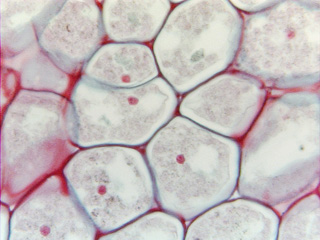 Fig. 3.1-5.
Transverse section of rhizome of blue cohosh (Caulophyllum thalictroides
in the barberry family) These parenchyma cells are somewhat unusual in that many
of them in the section have nuclei. Most
living parenchyma cells do have nuclei, of course, but usually the cells are so
large compared to the small size of the nuclei that a thin slice of tissue
rarely catches many nuclei – the nuclei of most cells are cut away so the
cells appear to be nonnucleate. The large number of nuclei here is due to the
cells being somewhat small for parenchyma cells, and the section is rather thick
(the section is so thick that the nucleus in the upper right hand corner is out
of the plane of focus – in a very thin section, it would have been cut away).
These cells have abundant gray contents but are not as full as they appear –
again, because the section is thick, we are seeing some contents along the front
or back wall in most cells. Each cell does have a large central vacuole, but
because the vacuoles are colorless, they do not stand out visibly compared to
the gray cytoplasm that lies either in front of or behind them.
Fig. 3.1-5.
Transverse section of rhizome of blue cohosh (Caulophyllum thalictroides
in the barberry family) These parenchyma cells are somewhat unusual in that many
of them in the section have nuclei. Most
living parenchyma cells do have nuclei, of course, but usually the cells are so
large compared to the small size of the nuclei that a thin slice of tissue
rarely catches many nuclei – the nuclei of most cells are cut away so the
cells appear to be nonnucleate. The large number of nuclei here is due to the
cells being somewhat small for parenchyma cells, and the section is rather thick
(the section is so thick that the nucleus in the upper right hand corner is out
of the plane of focus – in a very thin section, it would have been cut away).
These cells have abundant gray contents but are not as full as they appear –
again, because the section is thick, we are seeing some contents along the front
or back wall in most cells. Each cell does have a large central vacuole, but
because the vacuoles are colorless, they do not stand out visibly compared to
the gray cytoplasm that lies either in front of or behind them.